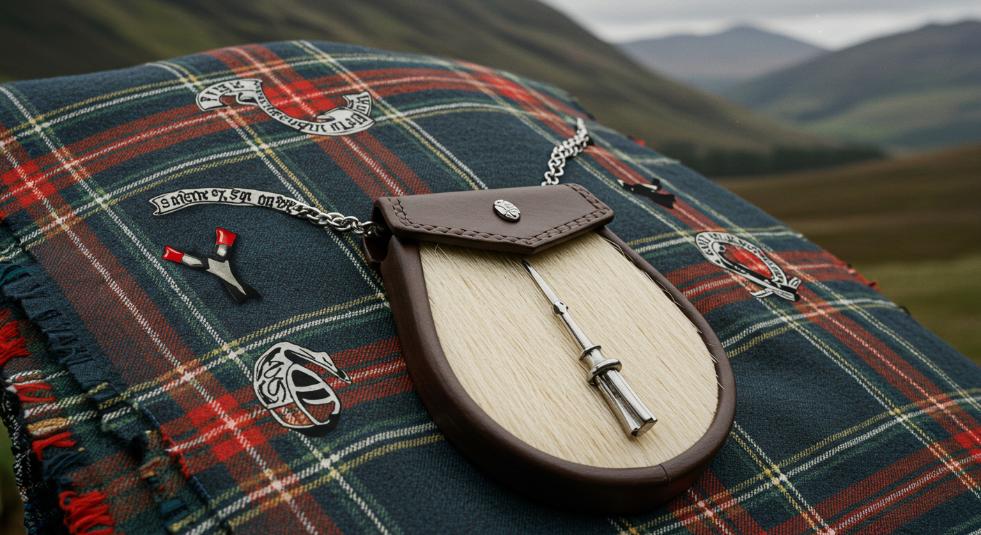Tartan Patterns: Decoding the Symbols and Stories Woven into Scottish Fabric

Tartan is often regarded as the fabric representing Scotland's cultural heritage. It is widely recognized for its vibrant patterns and distinctive checks. Beyond its appearance, tartan carries a rich history and profound significance, symbolically representing clans, regions, and even historical events. The patterns woven into tartan tell stories of Scotland's past and present. In this article, we will explore the origins of tartan, the meanings behind its patterns, and how this iconic fabric has woven its way into the global fashion landscape.
The Origins of Tartan
The history of tartan can be traced back to ancient times, with evidence of tartan-like patterns appearing in early Scottish history, particularly in the Highlands. However, the use of tartan as we know it today didn't fully evolve until the 16th century. Early tartans were woven from wool, and the availability of local materials and natural dyes dictated their designs. The fabric was initially utilitarian, created for warmth and durability, making it the perfect choice for the harsh Scottish climate.
The tartan patterns were often created using a simple weave of alternating colored threads, resulting in a checkered design. These early tartans were not necessarily associated with clans but with regions or individual families. Only later, in the 18th and 19th centuries, tartans became more standardized and began to represent specific Scottish Kilt clans.
Understanding the Fabric and Patterns
At its core, tartan is a fabric made from wool, characterized by its intersecting horizontal and vertical lines that form a grid-like pattern. Traditionally, tartan was woven using a simple over-under weaving technique, which produced a dense, durable fabric that could withstand the elements of the Scottish Highlands.
The colors and patterns used in tartan are not arbitrary; each tells a story. Scotland's different regions, families, and clans developed unique patterns over time. The complexity and significance of these designs increased as tartan became more closely linked to Scottish identity. The key to understanding tartan is recognizing that the colors, the arrangement of the lines, and the specific "sett" (the arrangement of the pattern) have a deeper meaning.
The Symbolism Behind Tartan Patterns
Tartan patterns are often associated with clans, regions, or historical events, making them symbolically rich. Each tartan design is unique and can carry a variety of meanings, usually based on the colors chosen and how they are arranged.
- Colors: The colors used in tartan are not just for aesthetic purposes; they often symbolize certain qualities. For example, green can represent the land or nature, while red is usually used to symbolize strength, passion, or courage. Yellow may symbolize the sun; blue is frequently associated with loyalty or the sky.
- The Clan Connection: One of the most significant tartan uses is to represent Scottish clans. Each clan traditionally had its distinct tartan passed down through generations. This tartan was used to identify members of the same clan, creating a sense of unity and pride. The patterns in the tartan were often chosen to reflect the geography and natural environment of the clan's homeland.
- The Regional Influence: While clan tartans are the most well-known, many tartans are tied to specific regions in Scotland. For example, the "Hunting" tartan is often associated with the Highlands. In contrast, the "Dress" tartan usually has a lighter, more elegant Scottish man in kilt design and is frequently worn during formal occasions.
Clan Tartan Patterns
Clan tartans are perhaps the most iconic and recognizable forms of tartan. Each Scottish clan has a distinct tartan pattern used to represent its members, and many of these patterns have been passed down through generations. Over the centuries, tartan became a symbol of loyalty and kinship, with each tartan becoming closely tied to the history of the clan it represented.
- MacGregor Tartan: One of the most famous tartans, the MacGregor tartan is known for its bold, dark patterns of red, green, and blue. It's associated with the MacGregor clan, one of the most influential clans in Scottish history.
- Stewart Tartan: The Stewart tartan, with its rich combination of red, green, and blue, is one of the most widely worn and recognized tartans. The Stewart clan is one of the oldest Scottish families, and their tartan is worn by those with Stewart lineage and by many people celebrating Scottish heritage.
- MacDonald Tartan: The MacDonald clan, one of the largest and most potent in Scottish history, also has a distinct tartan. The MacDonald tartan typically features bold, dark red, black, and green lines, symbolizing their strength and connection to the Highlands.
Each tartan pattern has its own story, often linked to the history, geographical location, or legacy of the clan it represents.
Tartan and Scottish Identity
Tartan has long been a symbol of Scottish identity, particularly after the Act of Proscription (1746), which banned the wearing of tartan following the Jacobite Rebellion. The British government feared that tartan was a symbol of resistance and rebellion. However, the ban was lifted in 1782, and the tartan quickly became a symbol of national pride, often worn during patriotic events and celebrations.
Today, tartan remains an enduring symbol of Scottish culture. It is worn proudly during national events, such as the Highland Games. It is also a fixture in formal Scottish dress, including kilts, sashes, and shawls. Tartan is also worn by Scots abroad, serving as a tangible connection to their heritage.
Global Influence of Tartan
While tartan is deeply embedded in Scottish culture, its influence has spread far beyond Scotland's borders. Tartan's bold, distinctive patterns have found their way into global fashion trends, often serving as a mark of rebellion or a symbol of traditional heritage.
In the 20th century, tartan gained international attention through its adoption by various fashion designers. Designers like Vivienne Westwood popularized tartan in punk fashion, where it was used to convey anti-establishment sentiments. Using tartan in punk culture gave the fabric a modern edge, far removed from its traditional roots.
Today, tartan is widely used in mainstream fashion, from casual wear to high-end fashion collections. The versatility of tartan, with its vast array of patterns and colors, allows it to blend tradition with contemporary style, making it a timeless fabric in formal and informal settings.
The Modern Role of Tartan
Tartan has remained an essential part of Scottish culture, not only in traditional Scottish kilt attire but also in modern expressions of Scottish identity. Scottish regiments, for example, continue to wear their respective tartans with pride, and tartan patterns are often seen in Scottish celebrations and festivals. Many people now use tartan for home décor and accessories, embracing its rich history while incorporating it into contemporary life.
Moreover, the rise of sustainable fashion has led to renewed interest in tartan as a durable and eco-friendly fabric. Using wool in tartan garments means they are both long-lasting and biodegradable, making them an excellent choice for those looking to invest in a timeless, sustainable fashion.
Conclusion
Tartan is more than just a fabric; it is a living, breathing symbol of Scotland's rich cultural history. From its humble beginnings as a practical fabric for the Highlanders to its status as a global fashion icon, tartan has remained an enduring symbol of Scottish identity, pride, and heritage. The stories woven into the patterns of tartan are a testament to the Scottish people's resilience, loyalty, and spirit. Whether worn as part of a kilt, used in fashion, or admired as an art form, tartan will continue to be an iconic part of Scotland's legacy for generations.


